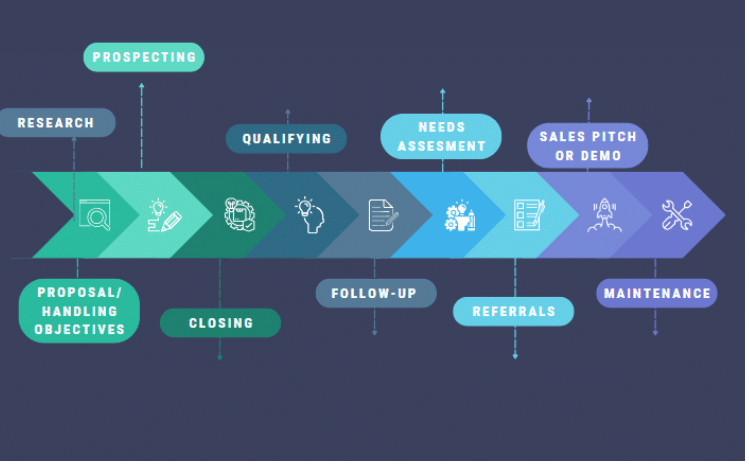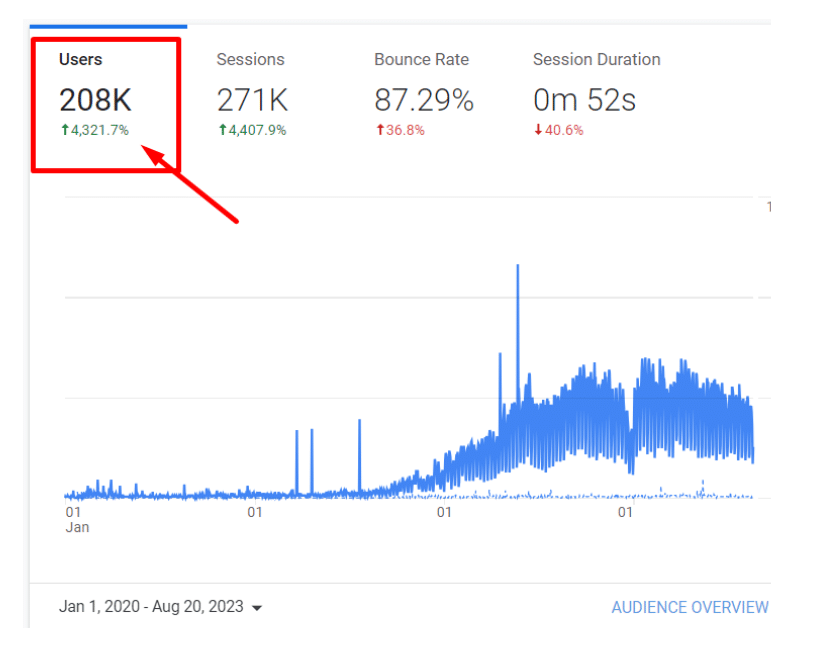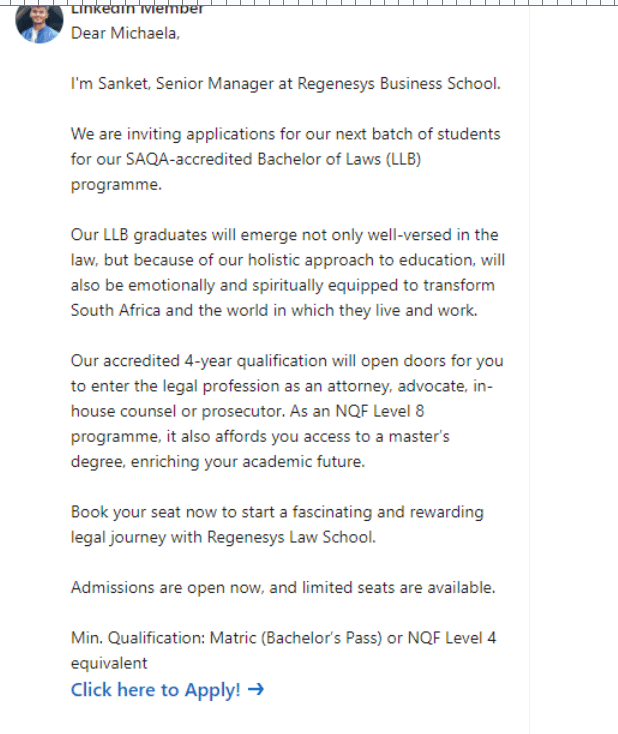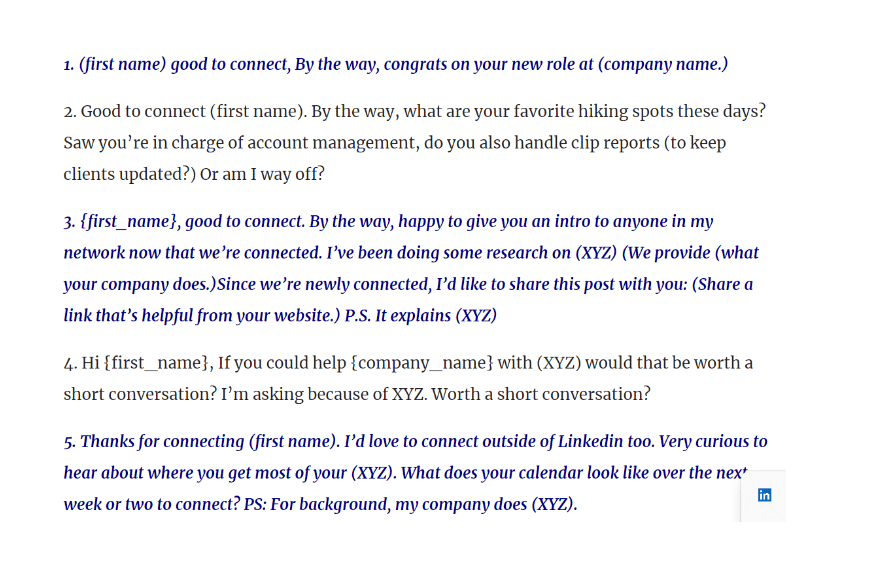There is one thing that all businesses need.
And it doesn’t matter if you’re a small business or a weathered enterprise you need constant sales qualified leads.
New qualified leads are the lifeblood of any business, and hopefully, if you can turn these leads into recurring b2b customers, you are set for a profitable future.
Unfortunately, without a solid lead generation strategy, you will get left behind with an empty sales pipeline.
You need new customers to continue growing as a business.
If you don’t have a sales strategy in place just yet, or if you have one, but it’s not working well, don’t worry.
We are here to help.
(And if you would like us to handle the selling process for you, we can help with that too. Just click here for a free 15-minute strategy call.)
This article will share some of the best b2b sales strategies to try out for more sales this year.
Firstly, what is a sales strategy?
(If you’re a professional marketer, feel free to skip this part.)

A b2b sales strategy is basically a set of decisions, research, actions and business goals that allow companies to find and convert their ideal buying customers.
This is a blueprint that your company can use to guide salespeople with clear objectives on how to close more deals, competitive analysis and product positioning.
Marketing strategies could include inbound and outbound. It all depends on who your ideal buyer is.
You might adapt your strategy based on various types of A/B testing, and choose the best option for your business.
Each company is different – Therefore it’s important to figure out which strategy works best for your business.
Below we will share some of the top b2b sales strategies to try this year.
What to consider before you begin your b2b sales process
1. Build a prospecting list based on current customers
At Salesbread we specialize in LinkedIn and cold email outreach, but one of the most important things to consider before implementing your strategy is figuring out who your ideal buying customer is.
You also have to go after prospects who:
- Need what you’re selling
- Have the budget to buy from you
- And have the purchasing power (the decision maker)
(Pro Tip: Interview your top sales rep and ask them what actually makes your prospective customers buy from you.)
Most marketers create buyer personas and know more or less who their target customers are, but we suggest creating a sales strategy based on current buying data.
This means that you need to have a look at WHO has purchased from you within the last 6 months.
Next, try to look for patterns between all your buying customers. The reason for this is that:
A.) It will help you build a look-alike list of prospects to go after.
B.) This gives you a very clear indication of which people to target.
For example, ask yourself what patterns do my b2b buyers have in common?:
- Which industry are all my buying customers in? Saas? Health? Marketing?
- How many employees do they have? More than 100? Less than 10?
- Where are your buyers located? The USA? 20 miles from Florida? Africa?
- Do they all use the same CRM tool?
- Have they recently been funded?
- What are their demographics?
- What services do these companies offer?
- Which departments or employees are on their payroll? HR? Chief financial officer? Sales teams?
- What are my buyer’s pain points? And how does my company help solve these issues?
- Who is making the purchasing decisions? The sales managers? Or the CEO?
When you can answer the above questions and look for patterns it makes it easier to go after the right potential customers.
This article: 34 Filters To Find Your Target Accounts is pretty helpful when it comes to looking for filters on who and how to find your ideal customer profile.
2.Where are your buyers spending most of their time?
There’s no point in having a LinkedIn outreach strategy if your buyers are mainly on Instagram.
You want to go after your buyers on the platform where they spend most of their time.
For example, we have noticed that a lot of crypto guys spend their time on Twitter. So reaching out to them on that platform would be the best.
3.What’s your budget and how much time do you have?
Implementing different sales strategies can be costly, depending on your needs. Besides this, if you’re a start-up you might not have a huge sales team under your belt just yet.
You might need to do a bit of sales as a founder initially.
And then when conversions increase you could always hire your first salesperson or marketer.
Some companies like to start off with an inbound sales strategy plan. This could be a bit of SEO and optimizing their websites; Others might prefer to use social media platforms, like Instagram, Linkedin or Facebook.
Or they might prefer outbound sales methods…
Initially, you might run these strategies on your own, or you could hire agencies to do this for you.
Whatever you decide, calculate the costs first and make sure that you know who to target first.
If you have a few good sales already and know exactly who to go after and how it will help an agency just improve on what you’re already doing.
Hiring an agency should scale what’s already working for your company.
Another option is building your own in-house sales team, which you can read about here.
4.Use personalization for b2b selling to be successful
If you aren’t personalizing your sales tactics in 2023, then the chances of more closed deals will be scarce and far between.
Stats have shown that buyers are interested in a personalized approach.
We have found that when messages are personalized during our LinkedIn outreach campaigns, we receive positive reply rates between 39-55% on average.
Here are some more stats on personalization

- “Companies earn 40% more revenue from personalization. In McKinsey’s report, companies were asked what percentage of their revenue came from personalization efforts or tactics. On average, companies earned 40% more revenue by adding personalization to their marketing strategy.”
- 90% of leading marketers say personalization significantly contributes to business profitability.” – Google
- 60% of consumers are likely to become repeat buyers following personalized experiences.
- 11% increase in ad click-through rates implemented from personalized first-party data.
- 89% of businesses are investing in personalization
- Personalized CTAs convert 202% better than default variants
Types of Sales Strategies
Inbound Methods
Inbound marketing refers to the following:
- Social selling
- Content marketing
- Social media marketing
- Influencer marketing
- SEO
Most companies make use of inbound marketing. You could either hire an agency to implement this for you, or you could start off initially on your own, or hire a marketer who specializes in specific forms of inbound marketing.
The only catch with inbound is that it takes time to grow a following on social media and create brand awareness.
You can expect it to take at least 12 months before you start seeing results.
For example, at Salesbread we have implemented a content marketing strategy.
We started off with receiving 200 clicks a month and now are receiving close to 12 000 clicks per month. This strategy has evolved over 2 years. But as you can see, users have increased by 4,321%.
So yes, it does work. But it takes time.

Tips for inbound sales strategies
5.Hire a writer with SEO experience or be prepared to send them on a course
If your company chooses to go the inbound route, make sure that you hire a writer that has experience with SEO. Or hire a writer and be willing to send them on some SEO courses.
You could find writers on Upwork, or even post on Linkedin. We suggest doing 2 paid trial articles and see which writer comes out on top.
Side Note:
Many marketers are using AI tools such as Chat GPT to write their content.
Artificial intelligence can be helpful, but in our opinion, we think that eventually, Google will still favor authoritative and unique pieces written by humans.
Using tools such as Chat GPT for creating SEO SERP-based outlines can be helpful to writers to optimize their content.
Just remember to still have your own unique spin on your niche and not have AI write your entire article. Rather use it as a supplement for better research and content analysis.
6.Have writers interview experts on the topic
In 2023, content marketing isn’t just about writing tons of articles. Your articles need to be informative and helpful.
You could even get your writer to interview those in your company who are the experts in your niche and write excellent thought-leadership-based articles.
7.Target bottom of the funnel keywords first
It’s also important to target bottom-of-the-funnel keywords because this will match buyer search intent. Choose keywords that aren’t super competitive, and once your content starts ranking you can try to go after more competitive keywords.
8.Post helpful content consistently
The same goes for any social media marketing that you might be interested in trying out. Make sure to post helpful content regularly.
Think about your target market and what would resonate with them.
If you post content on a regular basis, you will stay in the minds of your followers on social media.
9.Use conversion copywriting
Conversion copywriting isn’t sleazy sales pitches, but rather using things such as stats, case studies and testimonials to show your readers that you’re an expert in your field.
Social proof can do wonders for generating more successful sales.
Here’s an example of a sales strategy template for inbound marketing

Here’s an example of a sales strategy template for outbound marketing

Outbound Marketing Methods
Outbound marketing refers to methods such as:
- Cold calling
- Cold email outreach
- Linkedin outreach
- Billboards
- Trade Shows
It’s more of a traditional form of marketing.
The great thing about outbound is that if you have a super-refined list of your ideal target audience, you will get results relatively quickly.
At Salesbread 90% of our clients receive their first qualified sales lead within 48 hours after launching their campaign.
Effective sales strategies for Linkedin and cold email outreach
As mentioned above, you have to build an ultra-refined list of prospects first. Once that is done and your list is perfect you can start with the next steps.
10.Write personalized outreach messages based on research

Next, you have to research each prospect on your list if you would like to reach out to them via email or Linkedin.
The reason for this?
When you add a custom intro sentence that’s been written for that specific person, the chances of them reading and responding to your message will be so much greater.
If you received a message like this:

You would most probably respond, as opposed to something like this:

The second message is long and salesy. Besides this, the marketing team never did their research.
I have no interest in studying law. I’m a content writer.
(This approach of sending hundreds of messages out to the wrong kinds of people runs the risk of failure.
Not only are they wasting money, but they won’t reach their sales goals because their target market isn’t ultra-refined.
Rather have a small group of ultra-refined prospects than thousands who are a bad fit for your product or service.)
This article: How to Write Linkedin Prospecting Messages That Convert shares how to write expert personalized outreach messages for Linkedin and email using our CCQ method.
If you need some inspiration for writing connection requests read this article.
11.Be social, not salesy
When it comes to using Linkedin or cold email, don’t use sleazy sales pitches. Rather focus on your value proposition. How can your product or service really help your customer’s pain point?
If you can focus on building customer relationships by really helping them with their “bleeding neck” problem, the chances of reaching higher conversion rates will be greater.
When prospects smell even the tiniest of a sales pitch, they tend to ignore it.
Focus on just starting conversations by asking questions and being helpful.
You can then ask for a booked call where you can have a sales conversation about your product.
Here are some templates:

12.Follow up
With any outbound method whether it’s cold calls, cold emails or Linkedin outreach, make sure that you follow up consistently.
We suggest following up between 3 and 5 times every 3 days. (This article shares why we feel this is the best follow-up sequence.)
If you don’t receive any response try a different outreach channel.
So if you used Linkedin initially and didn’t receive a reply, try sending an email, an SMS or calling the prospect.
13.Use a low-commitment CTA
In your sales process make it as easy as possible for your prospect to actually respond. Don’t ask them to watch a 2-hour webinar, or sit in on a 60-minute demo.
Rather ask for a quick sales call at a time that works for the prospect.
Keep your CTA simple.
You could use the following CTA’s:

14.A quick side note on automation and sales tools for outreach
Automation has its place.
But if it’s not used correctly you could either have your Linkedin account restricted or develop a bad cold email sender reputation.
Remember to only use automation if you already have a good strategy in place that’s working.
Don’t use automation tools to spam prospects, by sending hundreds of the same messages. This won’t increase sales. In fact, the opposite might happen.
Use automation sparingly.
For example, you could use it to send follow-up messages, but once a prospect replies, you can then have a human reach out to them in real time and answer any questions they might have.
You should also invest in sales tools to help you build refined prospect lists, or find data.
For example, some tools to use could be:
- Linkedin sales navigator
- Quickmail.io
- Expandi
- Crunchbase
- CRM tools – Such as Salesforce or Hubspot
- Bombora
Cold calling strategies
Cold calling has a success rate of between 1 and 3%. It’s not everyone’s favorite form of a sales strategy but it can still be useful.
(If you’re looking for alternatives to cold calling read this.)
15.Use research and proper list building
If you do decide to go this route, remember that research is also incredibly important if you want to run a successful campaign.
Research your prospects and make sure that you’re reaching out to people who actually want what you’re selling. This will also allow you to customize offers according to your buyer’s needs.
16.Write a cold-calling script
A script can help you keep your thoughts in order. This is especially true for new team members who might be nervous. In your script have all the necessary information easily available, along with tips on how to handle rude clients.
You could also include answers to FAQs and objections that potential clients might have.
Remember a script is a guide and shouldn’t be read word for word.
17.Don’t start with a sales pitch
If you immediately jump into a sales pitch, prospects might just put the phone down.
Think about how you would feel if someone just started pitching a product without letting you say a word. You would probably be annoyed and end the call.
Rather take your time and ask the prospect about what they need. Tailor your offer to suit their needs and once you know what it is they are looking for, present your sales pitch.
18.Remember a cold call is a dialogue
Some sales reps end up talking waaaaay too much on a call. Remember to stop, breathe, and have a conversation.
Let clients talk about their needs and pain points. Be sure to ask them questions too, as this will help you understand what they are looking for, and how you can help them.
Sales Plan Template
When creating a sales plan here’s what should be included:
Use this as a guide.
- Mission and Background
- The Team
- Target Market
- Tools, Software, and Resources
- Positioning (Think about your place in your industry. Know your strengths, and weaknesses, compared to the competition.)
- Marketing Strategy (Choose strategies from above.)
- Prospecting Strategy
- Action Plan (How will you implement these strategies?)
- Goals (What are your goals and KPIS?)
- Budget
Need a sales strategy that guarantees 20+ qualified sales leads month?
Get in touch.
In the past 24 months Salesbread has generated close to 7000 qualified sales leads for our clients.
If you would like us to help you with a strategy or would like to use our done-for-you lead generation service, hop on a free 15-minute strategy call below.
